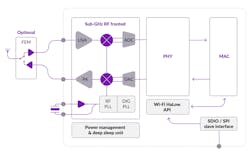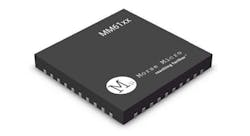Low-Power Wi-Fi HaLow Chips Support Long-Range Communications
Check out the other 2023 IDEA Award Nominees.
What you’ll learn
- What is Wi-Fi HaLow?
- Where Wi-Fi HaLow fits in the Wi-Fi spectrum.
- Features of the Morse Micro MM61xx family.
The IEEE 802.11ah Wi-Fi HaLow standard defines a sub-1-GHz implementation of Wi-Fi that provides longer operating range while sacrificing throughput. The idea is to provide connectivity on par with low-power wireless solutions but within the Wi-Fi framework. The top data rate for a single stream is 32.5 Mb/s, whereas top-end Wi-Fi standards using multiple antennas and the 2.4-, 5-, and 6-GHz bands can deliver multi-gigabit throughput that can stream 4K video and more. The main difference is that these high-bandwidth solutions require a lot more power.
Wi-Fi HaLow has 1-, 2-, 4-, and 8-MHz channel bandwidth. It uses the 900-MHz license-exempt bands utilized by other low-power devices from phones to sensor systems. It competes with low-power wireless solutions like Bluetooth, LoRaWAN, and Zigbee. Wi-Fi HaLow utilizes 26 channels at 100 kb/s. Maximum range is on the order of one kilometer. The maximum throughput of 347 Mb/s is achieved using four 16-MHz channels. At the low end is a single, 1-MHz channel using BPSK modulation. At the high end, the modulation is 256QAM.
Morse Micro’s MM61xx family is designed to provide low-power, Wi-Fi HaLow support to a host using an SPI/SDIO interface (Fig. 1). The MM6104 works with single streams up to 15 Mb/s while the MM6108 can handle data rates up to 32.5 Mb/s. Both interact with the host using an SPI/SDIO serial interface. They have options for UART and I2C communication plus GPIO and PWM support as well.
The wireless communication supports WPA3 security utilized on other Wi-Fi protocols. The systems fit into a 6- × 6- × 0.85-mm QFN48 package (Fig. 2). The chips can utilize an external PCB-mount power amplifier (PA) or front-end module (FEM) for ultra-long-reach applications. The chips are designed for low-power, extended sleep environments that use minimal battery power or run on power scavenging solutions.
Wi-Fi HaLow addresses a range of applications from IoT sensors and control to intelligent-grid and smart-metering applications. It could even be used in drone applications. The chips utilize bands between 850 and 950 MHz, allowing them to be employed worldwide, where available unlicensed bands may be different.
There's a similar standard called 802.11af that uses licensed bands under 1 GHz, between 54 and 790 MHz .



